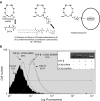Strategies for blocking the fibrogenic actions of connective tissue growth factor (CCN2): From pharmacological inhibition in vitro to targeted siRNA therapy in vivo
- PMID: 19294531
- PMCID: PMC2686750
- DOI: 10.1007/s12079-009-0043-9
Strategies for blocking the fibrogenic actions of connective tissue growth factor (CCN2): From pharmacological inhibition in vitro to targeted siRNA therapy in vivo
Abstract
Connective tissue growth factor (CCN2) is a major pro-fibrotic factor that frequently acts downstream of transforming growth factor beta (TGF-beta)-mediated fibrogenic pathways. Much of our knowledge of CCN2 in fibrosis has come from studies in which its production or activity have been experimentally attenuated. These studies, performed both in vitro and in animal models, have demonstrated the utility of pharmacological inhibitors (e.g. tumor necrosis factor alpha (TNF-alpha), prostaglandins, peroxisome proliferator-activated receptor-gamma (PPAR-gamma) agonists, statins, kinase inhibitors), neutralizing antibodies, antisense oligonucleotides, or small interfering RNA (siRNA) to probe the role of CCN2 in fibrogenic pathways. These investigations have allowed the mechanisms regulating CCN2 production to be more clearly defined, have shown that CCN2 is a rational anti-fibrotic target, and have established a framework for developing effective modalities of therapeutic intervention in vivo.
Figures




Similar articles
-
Connective tissue growth factor (CTGF/CCN2) in hepatic fibrosis.Hepatol Res. 2003 May;26(1):1-9. doi: 10.1016/s1386-6346(03)00115-3. Hepatol Res. 2003. PMID: 12787797
-
CCN2 is required for the TGF-β induced activation of Smad1-Erk1/2 signaling network.PLoS One. 2011;6(7):e21911. doi: 10.1371/journal.pone.0021911. Epub 2011 Jul 8. PLoS One. 2011. PMID: 21760921 Free PMC article.
-
Requirement for active glycogen synthase kinase-3β in TGF-β1 upregulation of connective tissue growth factor (CCN2/CTGF) levels in human gingival fibroblasts.Am J Physiol Cell Physiol. 2013 Sep 15;305(6):C581-90. doi: 10.1152/ajpcell.00032.2013. Epub 2013 Jul 3. Am J Physiol Cell Physiol. 2013. PMID: 23824844 Free PMC article.
-
Regulation of hepatic stellate cells by connective tissue growth factor.Front Biosci (Landmark Ed). 2012 Jun 1;17(7):2495-507. doi: 10.2741/4067. Front Biosci (Landmark Ed). 2012. PMID: 22652794 Review.
-
Signaling in fibrosis: targeting the TGF beta, endothelin-1 and CCN2 axis in scleroderma.Front Biosci (Elite Ed). 2009 Jun 1;1(1):115-22. doi: 10.2741/E12. Front Biosci (Elite Ed). 2009. PMID: 19482630 Review.
Cited by
-
Oral submucous fibrosis: an update.Clin Cosmet Investig Dermatol. 2015 Apr 13;8:193-204. doi: 10.2147/CCID.S80576. eCollection 2015. Clin Cosmet Investig Dermatol. 2015. PMID: 25914554 Free PMC article. Review.
-
Development of Normal and Cleft Palate: A Central Role for Connective Tissue Growth Factor (CTGF)/CCN2.J Dev Biol. 2018 Jul 19;6(3):18. doi: 10.3390/jdb6030018. J Dev Biol. 2018. PMID: 30029495 Free PMC article. Review.
-
Transforming growth factor-β (TGF-β)-mediated connective tissue growth factor (CTGF) expression in hepatic stellate cells requires Stat3 signaling activation.J Biol Chem. 2013 Oct 18;288(42):30708-30719. doi: 10.1074/jbc.M113.478685. Epub 2013 Sep 4. J Biol Chem. 2013. PMID: 24005672 Free PMC article. Clinical Trial.
-
Silencing of WISP3 suppresses gastric cancer cell proliferation and metastasis and inhibits Wnt/β-catenin signaling.Int J Clin Exp Pathol. 2014 Sep 15;7(10):6447-61. eCollection 2014. Int J Clin Exp Pathol. 2014. PMID: 25400723 Free PMC article.
-
Riboflavin alleviates cardiac failure in Type I diabetic cardiomyopathy.Heart Int. 2011 Sep 29;6(2):e21. doi: 10.4081/hi.2011.e21. Epub 2011 Nov 22. Heart Int. 2011. PMID: 22355488 Free PMC article.
References
-
- {'text': '', 'ref_index': 1, 'ids': [{'type': 'PubMed', 'value': '10809757', 'is_inner': True, 'url': 'https://pubmed.ncbi.nlm.nih.gov/10809757/'}]}
- Abraham DJ, Shiwen X, Black CM, Sa S, Xu Y, Leask A (2000) Tumor necrosis factor alpha suppresses the induction of connective tissue growth factor by transforming growth factor-beta in normal and scleroderma fibroblasts. J Biol Chem 275:15220–15225. doi:10.1074/jbc.275.20.15220 - PubMed
-
- {'text': '', 'ref_index': 1, 'ids': [{'type': 'PMC', 'value': 'PMC2387275', 'is_inner': False, 'url': 'https://pmc.ncbi.nlm.nih.gov/articles/PMC2387275/'}, {'type': 'PubMed', 'value': '12134160', 'is_inner': True, 'url': 'https://pubmed.ncbi.nlm.nih.gov/12134160/'}]}
- Abreu JG, Ketpura NI, Reversade B, De Robertis EM (2002) Connective-tissue growth factor (CTGF) modulates cell signalling by BMP and TGF-beta. Nat Cell Biol 4:599–604 - PMC - PubMed
-
- {'text': '', 'ref_index': 1, 'ids': [{'type': 'PMC', 'value': 'PMC2924405', 'is_inner': False, 'url': 'https://pmc.ncbi.nlm.nih.gov/articles/PMC2924405/'}, {'type': 'PubMed', 'value': '20522536', 'is_inner': True, 'url': 'https://pubmed.ncbi.nlm.nih.gov/20522536/'}]}
- Adler SG, Schwartz SM, Williams ME, Arauz-Pacheco C, Bolton WK, Lee TH, Coker G, Sewell KL (2006) Dose-escalation phase I study of FG-3019, anti-CTGF monoclonal antibody, in patients with type 1/2 diabetes mellitus and microalbuminuria. J Am Soc Nephrol 17:157A. doi:10.1681/ASN.2006111191 - PMC - PubMed
-
- {'text': '', 'ref_index': 1, 'ids': [{'type': 'PubMed', 'value': '16731742', 'is_inner': True, 'url': 'https://pubmed.ncbi.nlm.nih.gov/16731742/'}]}
- Aikawa T, Gunn J, Spong SM, Klaus SJ, Korc M (2006) Connective tissue growth factor-specific antibody attenuates tumor growth, metastasis, and angiogenesis in an orthotopic mouse model of pancreatic cancer. Mol Cancer Ther 5:1108–1116. doi:10.1158/1535-7163.MCT-05-0516 - PubMed
-
- Aoki Y, Maeno T, Aoyagi K, Ueno M, Aoki F, Aoki N, Nakagawa J, Sando Y, Shimizu Y, Suga T, Arai M, Kurabayashi M (2008) Pioglitazone, a Peroxisome Proliferator-Activated Receptor Gamma Ligand, Suppresses Bleomycin-Induced Acute Lung Injury and Fibrosis. Respiration. doi:10.1159/000168676 - PubMed
Grants and funding
LinkOut - more resources
Full Text Sources
Miscellaneous

